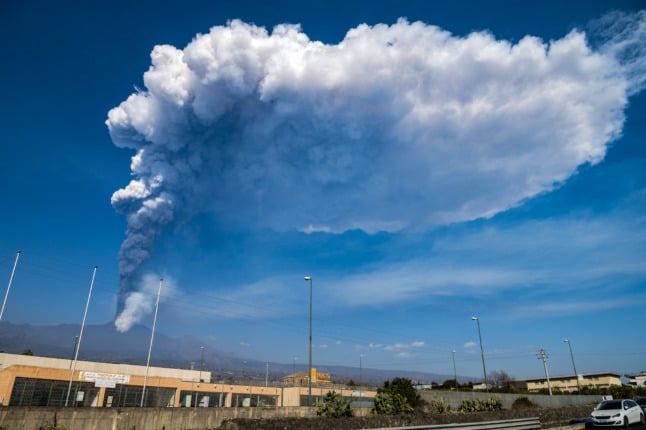The ash cloud rose 10 kilometres (6.2 miles) into the air above a crater on the south-east of the volcano, the INGV National Institute for Geophysics and Vulcanology said on Twitter.
E' in corso una fontana di lava al Cratere di Sud Est. La nube vulcanica ha raggiunto un'altezza di 10 km ca., e sulla base del modello previsionale si dirige verso Sud-Est. #Etna #ingv #osservatorioetneo
Il comunicato N.545 al link: https://t.co/tUqqCCieyg pic.twitter.com/uAWQzoMYzI— INGVvulcani (@INGVvulcani) February 21, 2022
The nearby Vincenzo Bellini international airport in Catania closed at lunchtime Monday until further notice, with inbound flights diverted to Palermo.
#etna live pic.twitter.com/qoZEZVuKzY
— Mario (@mr__freddo) February 21, 2022
READ ALSO: IN PHOTOS: A month of spectacular eruptions at Sicily’s Mount Etna
Eccolo in diretta 🌋#etna #volcan
🎥Marco Arcidiacono pic.twitter.com/KpQm7toC0p
— Sabrina F. (@itsmeback_) February 21, 2022
Ash covered roads, balconies and roofs of towns nearby, Italy’s Civil Protection Agency said.
Etna, l'eruzione si intensifica: il tremore continua a salire #Etna #localteam pic.twitter.com/GVSAiOy3pg
— Local Team (@localteamtv) February 21, 2022
INGV said it had recorded a gradual rise in volcanic-seismic tremor — induced by escaping gases — which could be a sign that Etna is heading towards another spectacular burst of fiery lava fountaining, known as paroxysmal activity.
Sua maestà #Etna pic.twitter.com/9VzR4x67ZA
— Paul81 (@paolocatanese) February 21, 2022
At 3,324 metres (nearly 11,000 feet), Etna is the tallest active volcano in Europe and has erupted frequently in the past 500,000 years.
On Twitter, Italians joked about the eruption.
“Your majesty Etna, can we get a break? Not five minutes goes by that you have to play some little joke on us?” read one.
Vostra maestà #Etna
Possiamo stare tranquilli?
Non è che le vengono i 5 minuti e ci fa qualche scherzetto?— Ninah (@Ninah04282351) February 21, 2022
Pointing out that the same event happened almost to the week last year, one Twitter user wrote, “Etna why do you like the month of February, do you want to tell us something?”
etna perché ti piace il mese di febbraio, vuoi dirci qualcosa?https://t.co/X3r4Pbmd7g
#Etna— anna (@anna_mar_f) February 21, 2022
And another called for “A minute of silence for all the laundry hanging up in Catania right now.”
Un minuto di silenzio per tutti i panni stesi a #Catania in questo momento. #Etna #MammaEtna
— veronica; (@veronsturn) February 21, 2022




 Please whitelist us to continue reading.
Please whitelist us to continue reading.
Member comments